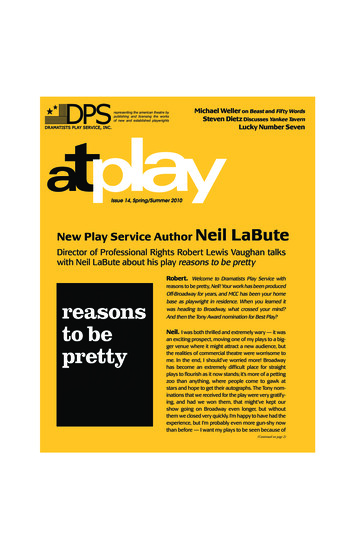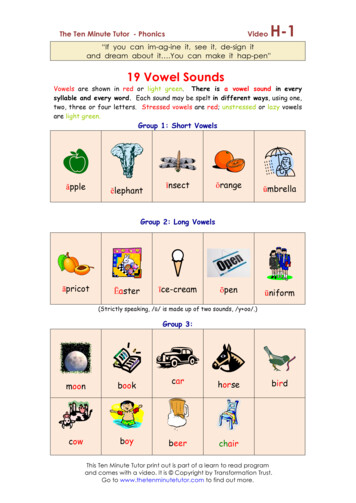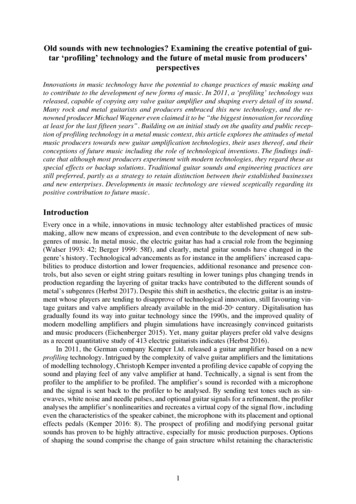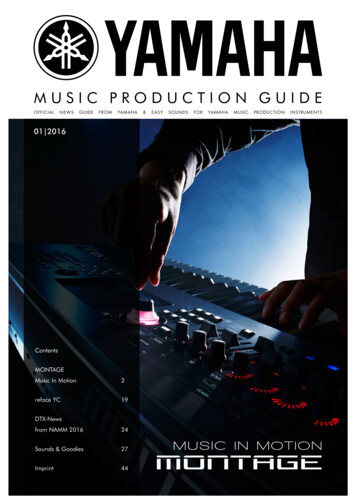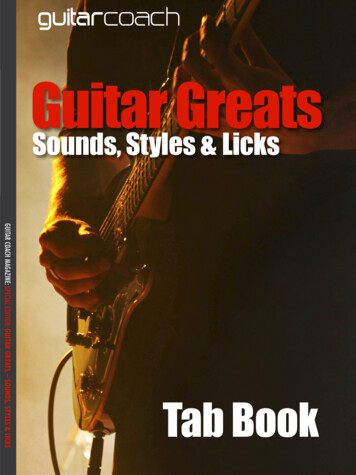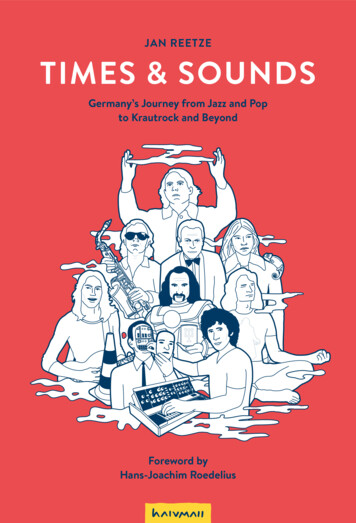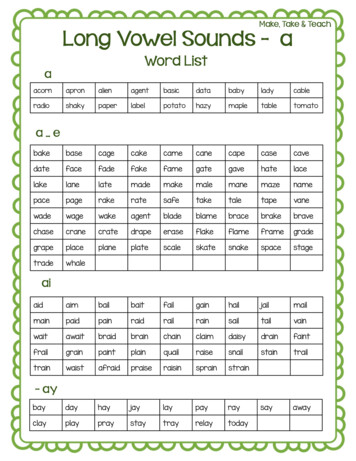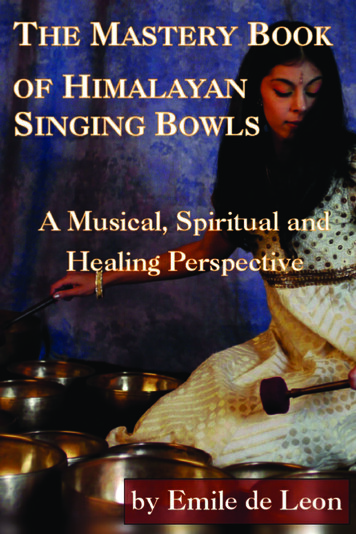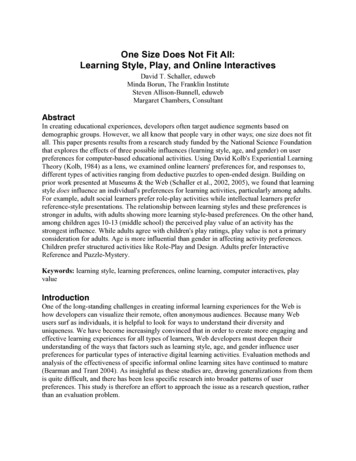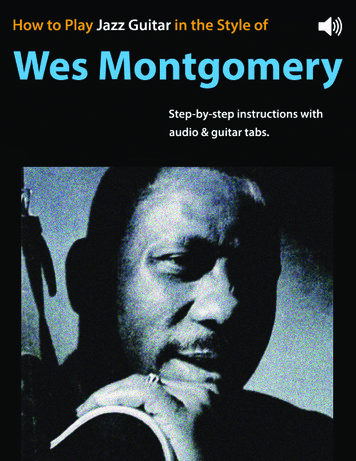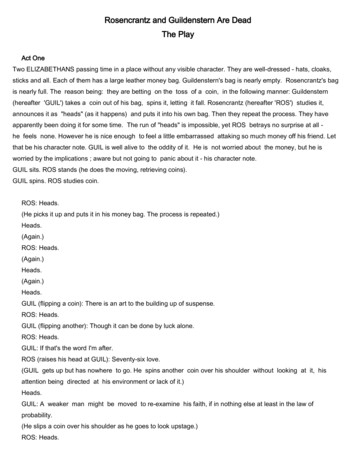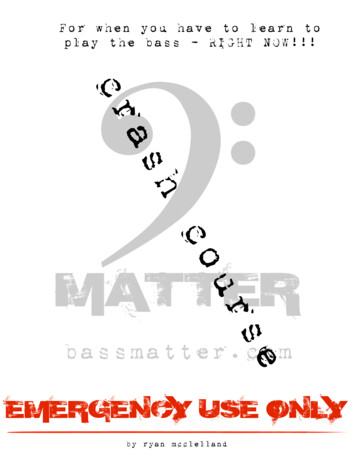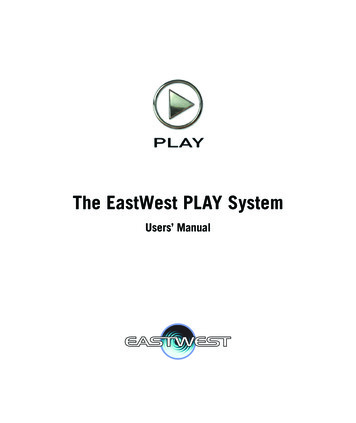
Transcription
The EastWest PLAY SystemUsers’ Manual
T h e E ast W est P L AY S ystemThe information in this document is subject to change without notice and does not represent a commitment on the part of East West Sounds, Inc. The software and soundsdescribed in this document are subject to License Agreements and may not be copiedto other media. No part of this publication may be copied, reproduced or otherwisetransmitted or recorded, for any purpose, without prior written permission by East WestSounds, Inc. All product and company names are or trademarks of their respectiveowners. East West Sounds, Inc., 2007. All rights reserved.East West Sounds, Inc.6000 Sunset Blvd.Hollywood, CA 90028USA1-323-957-6969 voice1-323-957-6966 faxFor questions about licensing of products: licensing@eastwestsounds.comFor more general information about products: .comVersion of October 2008ii
T h e E ast W est P L AY S ystemCreditsProducerDoug RogersSoftware DevelopmentKlaus Voltmer, Patrick Stinson, Stefan Kersten, Klaus Lebkücher,Toine Diepstraten, Stefan Podell, Ezra Buchla, Nicholas Cardinal,Jonathan Kranz, David Kendall, Günter Hirscher, Olivier Frappier,Doug Rogers, Nick Phoenix, Rhys Moody, Stefan LeisteManualJohn Philpitiii
T h e E ast W est P L AY S ystem1. Welcome2 About EastWest3 Producer: Doug Rogers5 EastWest Studios8 How to Use This and the Other Manuals9 Online Documentation and Other ResourcesClick on this text to open theMaster Navigation Document1
T h e E ast W est P L AY S ystemWelcomeAbout EastWestEastWest (www.soundsonline.com) has been dedicated to perpetual innovation and uncompromising quality, setting the industry standard as the most critically acclaimedproducer of Sample CDs and Virtual (software) Instruments.Founder and producer Doug Rogers has over 30 years experience in the audio industryand is the recipient of many recording industry awards including “Recording Engineer ofthe Year.” In 2005, “The Art of Digital Music” named him one of “56 Visionary Artists &Insiders” in the book of the same name. In 1988, he founded EastWest, the most critically acclaimed sound developer in the world, and recipient of over 50 industry awards,more than any other sound developer. His uncompromising approach to quality, and innovative ideas have enabled EastWest to lead the sound-ware business for 20 years.In 1997 Rogers partnered with producer/composer Nick Phoenix and set up QuantumLeap, a wholly owned division of EastWest, to produce high-quality, no-compromise sample libraries and virtual instruments. Quantum Leap virtual instruments are mostly produced by Nick Phoenix. Some of the larger productions, such as Symphonic Orchestra,Symphonic Choirs and Quantum Leap Pianos are co-produced by Doug Rogers and NickPhoenix. As a composer, Phoenix began scoring film trailers and television commercialsin 1994. To date, he has either scored or licensed music for the ad campaigns of over1000 major motion pictures including Tomb Raider 2, Terminator 3, Lord of the RingsReturn of the King, Harry Potter 2, Star Wars Episode 2, Spiderman 3, Pirates of theCaribbean 3, Blood Diamond, Night at the Museum, and The Da Vinci Code. QuantumLeap has now firmly established itself as one of the world’s top producers of high-endsample libraries and virtual instruments.In 2006, EastWest purchased the legendary Cello Studios (formerly United Western Recorders) on Sunset Boulevard in Hollywood, re-naming it EastWest Studios. The 21,000sq. ft. facility, since remodelled by master designer Philippe Starck, houses five recording studios and is the world headquarters for EastWest.Chapter1: Welcome2
T h e E ast W est P L AY S ystemProducer: Doug RogersDoug Rogers has over 30 years experience in the audio industry and is the recipient ofmany recording industry awards including “Recording Engineer of the Year.” In 2005,“The Art of Digital Music” named him one of “56 Visionary Artists & Insiders” in the bookof the same name. In 1988, he founded EastWest, the most critically acclaimed sounddeveloper in the world, and recipient of over 50 industry awards, more than any othersound developer. His uncompromising approach to quality, and innovative ideas haveenabled EastWest to lead the sound-ware business for 20 years.In the late eighties, he released the very first commercial drum sample CD, and followedit with the multiple-award-winning “Bob Clearmountain Drums” sample collection. Inthe years that followed he practically reinvented the sound-ware industry. EastWest introduced loop sample libraries to the market in the early nineties, followed closely bythe first midi driven loops (Dance/Industrial). He released the first sample library toinclude multiple dynamics, followed by the first sample library to stream from hard disk,an innovation that led to the detailed collections available today. His recent productionsare Symphonic Orchestra (awarded a Keyboard Magazine “Key Buy Award,” EQ Magazine “Exceptional Quality Award,” Computer Music Magazine “Performance Award,” andG.A.N.G. [Game Audio Network Guild] “Best Sound Library Award”); and SymphonicChoirs (awarded Electronic Musician “2006 Editor’s Choice Award,” G.A.N.G. “BestSound Library Award,” and Keyboard Magazine “Key Buy Award”).He persuaded audio legend Prof. Keith O. Johnson to record EWQLSO and EWQLSC,and came up with the revolutionary idea of recording all instruments and voices with 3simultaneous stereo mic setups so users can control the tone of the performances andChapter1: Welcome3
T h e E ast W est P L AY S ystemthe acoustics of the concert hall, as well as create surround sound mixes. His latestproductions include Quantum Leap Pianos, another 3 mic setup, and the most detailedvirtual piano collection ever produced; and Fab Four, inspired by the sounds of the Beatles, featuring the same kind of vintage instruments and original EMI/Abbey Road recording equipment as the Beatles used to create their music. He persuaded audio legendKen Scott, who was involved in the recording of five Beatles albums and an engineer for“Magical Mystery Tour” and “The Beatles” (also known as the White Album) to work withhim on Fab Four. He also acquired one of Hollywood’s most famous recording studiocomplexes in 2006, formerly United Western (now EastWest Studios), recipient of moreengineering awards and RIAA certified Gold and Platinum recordings than any otherstudios worldwide. He persuaded top international design superstar Philippe Starck toredesign the non-technical areas of the studios.Over the last decade he has partnered with producer/composer Nick Phoenix and set upthe Quantum Leap imprint, a subsidiary of EastWest, to produce high-quality, no compromise sample libraries and virtual instruments. EastWest/Quantum Leap virtual instruments are considered the best available and are in daily use by the who’s who of theindustry. His latest technical achievement was unveiled at the 2007 NAMM convention- the world’s first 64-bit audio engine named PLAY, which powers EastWest/QuantumLeap’s latest suite of virtual (software) instruments.Chapter1: Welcome4
T h e E ast W est P L AY S ystemEastWest StudiosEastWest Studios (formerly United Western Recorders) is the world’s premiere studio.Here is a quote from page 33 of the book Temples of Sound: “United Western Recordershas been the scene of more hit records—from the 1950’s to right now—than any otherstudio. No other studio has won more technical excellence awards, and no other studiohas garnered as many Best Engineered Grammys as this complex of studios on SunsetBoulevard.” One thing everyone agrees on: The acoustics and the vibe in the recordingrooms of 6000 Sunset Boulevard are unmatched.EastWest Studios has hosted the who’s who of music for over 45 years. In the beginning, artists like Bing Crosby, Frank Sinatra, Dean Martin, Sammy Davis, Nat King Cole,Johnny Mercer and Ray Charles were recording the hits of the day. Ray Charles’ classic,“I Can’t Stop Loving You” was recorded here as well as Sinatra’s, “Strangers In The Night”and “That’s Life,” and the legendary Beach Boys “Pet Sounds” album, which was the inspiration for The Beatles’ “Sgt. Peppers” album, was recorded here also. The Mamas andPapas “California Dreamin,” “Monday Monday,” and Scott McKenzie’s “San Francisco”were recorded here. Elvis Presley recorded his 1968 Christmas special in Studio 1. Famous themes for film and television were recorded here including the “M*A*S*H” theme,Chapter1: Welcome5
T h e E ast W est P L AY S ystem“Mission Impossible” theme, “Hawaii Five-O” theme, “Beverly Hillbillies” theme, “Godfather” theme, plus much of the “Monkees” and “Partridge Family” television series.It would be impossible to name all the musical royalty who have worked at EastWestStudios, but here are some of them (in alphabetical order) Christina Aguilera, HerbAlbert, America, Paul Anka, Fiona Apple, Audioslave, Franky Avalon, Barenaked Ladies,Better Than Ezra, Blondie, Buffalo Springfield, Burt Bacharach, Beach Boys, Blink 182,Glen Campbell, Canned Heat, Vickie Carr, Carpenters, Johnny Cash, David Cassidy, RayCharles, Chicago, Petula Clarke, Ry Cooder, Elvis Costello, Count Basie & Orchestra, EricClapton, Nat King Cole, Natalie Cole, Ornette Coleman, Duane Eddy, Jan & Dean, JohnColtrane, Petula Clark, Joe Cocker, Sam Cooke, Bing Crosby, Bobby Darin, Sammy Davis,Jr., Jackie DeShannon, Duke Ellington, Neil Diamond, Fifth Dimension, Bob Dylan, ElllaFitzgerald, Benny Goodman Big Band, Grateful Dead, Grass Roots, Green Day, GuessWho, Lani Hall, Herbie Hancock, Don Ho, Whitney Houston, Howlin’ Wolf, Janis Ian,Ike & Tina Turner, Incubus, Isley Brothers, Michael Jackson, Elton John, Stan Keaton,Carole King, Kris Kristofferson, Franky Laine, K.D. Lang, Avril Laverne, Michel LeGrand,Peggy Lee, Little Feat, Trini Lopez, Madonna, Mamas & the Papas, Dean Martin, JohnnyMathis, Meatloaf, Sergio Mendez & Brazil 66, Metallica, Johnny Mercer, Paul McCartney,Barry Manilow, Scott McKenzie, Natalie Merchant, Bette Midler, Monkees, Alanis Morrissette, Motley Crue, Muse, Rick Nelson, Willie Nelson, Wayne Newton, Harry Nilsson,Nitty Gritty Dirt Band, Ozzy Osborne, Partridge Family, Paul Revere and the Raiders,Tom Petty and the Heartbreakers, Pointer Sisters, Iggy Pop, Elvis Presley, Lisa MariePresley, Billy Preston, Rage Against the Machine, Red Hot Chilli Peppers, Kenny Rogers, Rolling Stones, Ronnie & the Ronettes, Bonnie Raitt, Helen Reddy, R.E.M., NelsonRiddle, Righteous Brothers, Johnny Rivers, Ronnie & the Ronnettes, Dianna Ross, Santana, Jimmy Smith, Sonny & Cher, Phil Spector, Tom Scott, Carly Simon, Frank Sinatra,Nancy Sinatra, Bruce Springsteen, Steppenwolf, Rod Stewart, Mathew Sweet, StoneTemple Pilots, Barbra Streisand, System of a Down, Temptations, The Animals, The Association, The Four Tops, The GoGos, The Kingston Trio, The O’Jays, The Vines, The Who,Mel Torme, U2, Richie Valens, Stevie Wonder, Tool, Turtles, Sarah Vaughn, Jimmy Webb,Weezer, Andy Williams, Nancy Wilson, Young Rascals, Frank Zappa.EastWest HistoryWhat’s now called EastWest Studios was founded by Bill Putnam in 1961. Consideredto be the “Father of modern recording,” he is acknowledged to be the first person touse artificial reverberation for commercial recording. He also developed the first multiband equalizers and, with his company Universal Audio, was responsible for the development of classic equipment like the Urei 1176LN and Urei Time Align Monitors. Hewas involved in the early development of stereophonic recording and founded studios inChicago, Hollywood, and San Francisco. He was responsible for a number of innovationsincluding: the first use of tape echo and echo chambers, the first vocal booth, the firstmultiple voice recording, the first use of 8-track recording, half-speed disc mastering.In 1957, he started United Recording Corp. in a building at 6050 Sunset and startednew construction on new studios. Stereo was taking off and Putnam was determinedto incorporate as many technological innovations into the new complex as possible. InChapter1: Welcome6
T h e E ast W est P L AY S ystem1961, Western Recorders (now EastWest Studios) at 6000 Sunset was acquired, remodeled, and incorporated into the complex with the facilities being known as UnitedWestern Recorders. After Bill Putnam passed away in 1989, the studio was acquired byAllen Sides and renamed Oceanway recording. In 1999 Rick Adams acquired the studiosand renamed it Cello, and in January 2006 it was acquired by Doug Rogers of EastWestSounds, the #1 sounds producer in the world, with over 50 international awards.Looking for a designer to take on the task of refurbishing the exterior and non-technicalinterior areas, while preserving the historic studios, Rogers contacted renowned designerPhilippe Starck, whose trend-setting work is known the world over for its sheer brillianceand beauty. Starck jumped at the opportunity and headed to Hollywood. He insisted onrestoring all historic elements inside and out, adding new designs to the interior and creating a new exterior look that incorporated elements of the current one. Rogers stronglysupported this. Plans are also afoot by Rogers to add historic names and records to thesidewalk on Sunset Boulevard, giving the illustrious studio its own walk-of-fame. Anotherhighlight of the restoration has included Rogers’ purchase of other analog studio equipment to be used for recording the classic way and not just digital (including two EMImixing boards that the Beatles used to record their hits). His plans for reactivating thestudios are a model for historic and cultural preservation as well as providing EastWestwith the finest recording environment in the world. In addition to EastWest’s own use ofthe facilities, the five studio complex will be open to a limited number of outside clientsafter the Starck restoration.Chapter1: Welcome7
T h e E ast W est P L AY S ystemHow to Use This and the Other ManualsAll documentation for the EastWest PLAY Advanced Sample System and its libraries isprovided as a collection of Adobe Acrobat files, also called PDFs. They can be viewed onthe computer screen or printed to paper.One advantage of reading this material on a computer screen is the availability of hyperlinks within the document. These links provide the ability to jump directly to a referenced page elsewhere in the same or a companion document with the click of the mouse.When the mouse cursor moves over such a link, it changes appearance. Such hyperlinksare available in the list of sections in each chapter title page, as well as for certain individual words and phrases within the chapters.By opening the Bookmarks pane along the left edge of the Adobe Acrobat Reader, theuser can jump directly to a topic from the section names, or to a specific page by clickingon one of the page thumbnails (small images of each page). Note that some older versions of Acrobat Reader might not support all these features. The latest Acrobat Readercan be downloaded and installed at no cost from the Adobe web site. (As an example ofa hyperlink, click on the last word of the previous sentence to be taken directly to theAdobe site.)When reading this and other manuals on the computer screen, you can zoom in to seemore detail in the images or zoom out to see more of the page at once. If an includedpicture of the user interface, or a diagram, seems fuzzy or illegible, then zoom in usingone of several means provided in the Acrobat Reader software.A Note on the Included ImagesEvery library that’s part of the EastWest PLAY System has a somewhat different lookonscreen from the others. The backgrounds vary; the controls are in different places;controls present in one library do not exist in some of the others. As a consequence, thepicture of the user interface (UI) in this manual may not be exactly the same as what yousee on your screen. The images here were captured from the various libraries availablewhen this manual was written.For images from a specific library, read the manuals for the individual libraries, as described in the next section.Manuals for the Specific LibrariesEach library in the collection of EastWest and Quantum Leap instruments has its ownmanual. These are separate PDF documents that are copied to your computer’s harddrive when each library is installed. Look in the following directories to find the documentation files. On a Windows PC: \Program Files\EastWest\Documentation On a Macintosh: \Applications\EastWest\DocumentationChapter1: Welcome8
T h e E ast W est P L AY S ystemLibrary-specific information, such as the controls in the user interface the modifiable parameters for the articulations the list of available articulations, and their intended uses and so onis described in the library PDFs. A description of how to use the PLAY system, the PLAYsoftware, and any information common to all libraries (for example, how to install them)is contained in this manual.The Master Navigation DocumentBecause the EastWest PLAY System is a collection of components, each with its ownUser’s Manual, a Master Navigation Document (MND) is provided to allow users to jumpquickly between these PDFs when being read on the computer screen. This MND is aone-page file with hyperlinks to the PLAY System documentation and to all the librarymanuals. Hyperlinks to this Master Navigation Document are found in the lower-rightcorner of the title page of each chapter in each document. From there, you can open anyother document in the collection.For example, if you’re reading something in the documentation for the Quantum LeapPianos library, and need to open the manual for the PLAY System as well, go to anychapter title page and click on the link that says, “Master Navigation Document.” It willopen in a new window on the computer screen. In that document, click on the icon forthe PLAY System and its manual will open in the same window (hiding the MND). Younow have both the Pianos library manual and the PLAY System manual open in separatewindows so you can refer to them both.Online Documentation and Other ResourcesFor the most up to date information, visit the support pages at EastWest’s web site.There you can find: information made available after these manuals were written FAQ pages that may already list answers to questions you have suggestions from EastWest and other users of the EastWest PLAY System news about upcoming releasesThe address is:http://support.soundsonline.comYou can also visit the EastWest online forums. There you can read comments and questions from others who use EastWest products and post your own. The many forum participants are a good source of helpful information about both the technical and musicalaspects of this software.The address of the forums is:http://www.soundsonline-forums.comChapter1: Welcome9
T h e E ast W est P L AY S ystemCurrent PLAY LibrariesAs EastWest and Quantum Leap add new libraries to the PLAY System, they all work withthe same PLAY Advanced Sample Engine you’re running right now. To see a list of all thecurrently available virtual instruments and/or to purchase them online, click on one ofthe following links to an online page.For the United or 4.htmlChapter1: Welcome10
T h e E ast W est P L AY S ystem2. The EastWest PLAY System, An Overview121213The ArchitectureThe PLAY Advanced Sampling EngineThe PLAY System LibrariesClick on this text to open theMaster Navigation Document11
T h e E ast W est P L AY S ystemThe EastWest PLAY System, an OverviewThe ArchitectureThe EastWest PLAY System is a collection of components that work together to create music in an electronic environment. The heart of the system is the PLAY Advanced SampleEngine, a software sample player designed to work with any of the libraries created especially for it. The PLAY Sample Engine can run on a Macintosh computer or a WindowsPC, and on both 32-bit and 64-bit platforms.The PLAY Advanced Sample Engine can generate no sound unless it is loaded withsamples from one or more of the PLAY System Libraries. The engine takes samples—shortrecordings of live instruments—from one or more libraries plus MIDI data and moldsthem into a musical expression: a single note, an entire piece, or anything in between.When you buy the license for an EastWestor Quantum Leap library, the license forthe PLAY Sample Engine is included. Asyou install more libraries on the samecomputer, they can all use the samePLAY Sample Engine.The PLAY EngineThe PLAY Advanced Sample Engine is anEastWest software program that knowshow to open and play samples in the associated libraries. It contains the bestsounding and most powerful effects engine available, built from the ground upfor superior quality.One of the primary initial design pointsfor the engine was playability. Insteadof forcing the user to focus on technical issues, the PLAY System provides themusician intuitive control of each instrument.The look of the PLAY Engine on the screen depends on what library is currently selected.The images on this page show two examples (with a red line between them) of how thePLAY Engine changes when displaying instruments from different libraries. The two li-Chapter2: The EastWest PLAY System: An Overview12
T h e E ast W est P L AY S ystembraries in these examples are the Quantum Leap Pianos and Fab Four. Some aspects ofthe user interface, such as the selection controls at the top and the keyboard at the bottom (not shown here), remain relatively constant through all libraries. The controls in thecentral section are library-specific and can have very different layouts to accommodatethe varying needs of each library.The PLAY Engine can be run in either of two modes, as needed: In Standalone Mode the PLAY Engine runs as its own program. MIDI and audio connections are usually made directly with the sound card’s driver. In Plug-in Mode the Play Engine runs as part of a host program, usually a sequencer.The host handles all MIDI and audio connections.When in Plug-in mode only, it is possible to open more than one instance of the PLAYEngine at a time. One consideration in deciding how many instances to open simultaneously is the question of how many instruments you want to be able to be able to manipulate at once through its library’s user interface. (There are other considerations, as well,some of which may be determined by your choice of host and/or working environment.)Only one instance of the standalone PLAY Engine can be running at a time. It’s possibleto open as many instruments within that instance as your computer’s resources allow.The number of unique MIDI channels for playing instruments within a standalone PLAYEngine is limited by the number of MIDI ports defined; for example, if 10 MIDI ports areavailable then 160 instruments can create 160 unique channels. (That’s 10 ports times16 MIDI channels per port.)The EastWest PLAY Advanced Sample Engine uses 64-bit processing to take full advantage of the benefits of the new breed of 64-bit processors and operating systems thatare starting to become available. That means accessibility to significantly larger amountsof RAM and, therefore, the ability to load many times the number of instruments. (TheEastWest software also supports 32-bit processing for full backwards compatibility witholder computers and OS’s.)For documentation on a specific library and its instruments, go to the separate documentation for each library. Or open the PLAY System’s Master Navigation Document,described on page 9.The PLAY System LibrariesIn simplest terms, each library can be thought of as comprising: a user interface (UI), the display on the screen and its visible controls its instruments its samples(A more in-depth description is provided in the library-specific manuals.)Chapter2: The EastWest PLAY System: An Overview13
T h e E ast W est P L AY S ystemAll libraries use the same PLAY Advanced Sample Engine to load and play their instruments. That approach has two consequences worth mentioning here: The fist time you install one of these libraries, the PLAY Engine is installed. On subsequent installations on the same computer, the setup program installs the new libraryand then determines whether the already installed PLAY Engine requires an update. In any given instance of the PLAY Engine, you can load instruments from any libraryinstalled and authorized on that computer. For example, let’s say you open an instanceof PLAY and load a Fab Four guitar. You can then load a drum from the Stormdrum 2library in the same instance. When loading instruments, you can think of all instruments in all the PLAY System libraries you have licensed as a single collection.Libraries and Instruments in the Browser ViewThe Browser view is your access to all instruments within all installed libraries. SeeChapter 8 for a more complete description and instructions on how to find specific instruments.Chapter2: The EastWest PLAY System: An Overview14
T h e E ast W est P L AY S ystem3. Hardware and Software Requirements1617System RequirementsSupported Audio DriversClick on this text to open theMaster Navigation Document15
T h e E ast W est P L AY S ystemHardware and Software RequirementsYou can run the EastWest PLAY System on any Windows or Apple Macintosh system thatcomplies with the specifications listed below. Each retail package includes all the filesnecessary to function on either the Windows or Macintosh platform. The requirementslisted in this chapter provide a minimum standard required to operate and hardwarerecommendations for optimal functioning. Using a more powerful computer system thanthe recommendations—a faster processor, more memory (RAM), a hard drive with morespace and/or faster rotation, and so on—is encouraged for larger projects. See the suggestions for improving performance in the online FAQ (Frequently Asked Questions) pageat http://support.soundsonline.com.System RequirementsThe table on the next page lists the computer hardware required to install the PLAY Advanced Sample Engine and to run a small project. These are guidelines only; the amountof concurrent processing (including the sequencer, audio and effects processors, otherplug-ins, and so on) can affect the power of the computer resources needed to accomplish any specific task.System RequirementsComputer TypeOperating SystemHardwareWindows PC(Required) XP SP2 or VISTA P4 2.5 GHz or faster processor1 GB of RAMDVD drivesound cardiLok keyenough free hard drive space for the libraries*Internet connection required for one‑timeproduct activationcontinuedChapter3: Hardware and Software Requirements16
T h e E ast W est P L AY S ystemSystem RequirementsComputer TypeOperating SystemWindows PC(Recommendations)Macintosh(Required)Hardware Core duo or better processor 2 GB of RAM sound card with ASIO drivers OS 10.4 or higherMacintosh(Recommendations) G4 1 GHz or faster processor1 GB of RAMDVD driveiLok security key (not included)enough free hard drive space for the libraries*Internet connection required for one‑timeproduct activation Core Duo or better processor 2 GB of RAM* See the library-specific manuals to learn how much free hard disk space is required foreach library. If installing more than one library, the hard drive must have enough freespace to accommodate the sum of all the individual libraries.The retail copy of the library does not include an iLok security key in the box. If you donot already own one from another software product, you can buy one at your EastWestdealer or online at:www.soundsonline.com/ilokSee the section starting on page 26 for more information on the iLok security key.Supported Audio DriversThe PLAY System requires an audio driver to connect to the sound card in the host computer. A variety of different sound cards are available on the Windows and Mac platforms,each with its own driver. These drivers are normally installed with the sound card, orthey can be acquired separately. Contact the manufacturer of your sound card for moreinformation.The table on the next page specifies which audio drivers the PLAY Engine can work withon each platform. Note that when the PLAY Advanced Sample Player is running as aplug-in, it uses whichever audio driver is selected in the host’s setup parameters. In thiscase, the type of audio driver does not matter as long as your host is compatible with thatdriver. For this information, please read your host’s manual.Chapter3: Hardware and Software Requirements17
T h e E ast W est P L AY S ystemAudio DriversComputer TypeSupported DriversWindowsASIO, DirectSound, VSTMacAudio Units, Core Audio, VSTNote: The information and specifications in this manual are subject to change withoutnotice.Chapter3: Hardware and Software Requirements18
T h e E ast W est P L AY S ystem4. Installation and Authorization20 Installation, an Overview20 Preparing to Install a PLAY System Library21 Installation Instructions on a Windows Computer24 Installation Instructions on a Macintosh Computer26 Authorization, an Overview26 The iLok Security Key27 Authorization InstructionsClick on this text to open theMaster Navigation Document19
T h e E ast W est P L AY S ystemInstallation and AuthorizationWhether you are installing your first PLAY System library on this computer, or whetheranother library is already installed, the process is the same. An Installation Wizard takesyou step-by-step though the process of copying files and setting up parameters in theoperating system. Then an Authorization Wizard authenticates your unique license authorization code online. This chapter and the next walk you through all the steps with thegoal of setting up a system that’s ready to use.Installation, an OverviewThis manual refers to the process of installing a PLAY System library, which includes noton
Founder and producer Doug Rogers has over 30 years experience in the audio industry and is the recipient of many recording industry awards including “Recording Engineer of the Year.” In 2005, “The Art of Digital Music” named him one of “56 Vision
